29 June
Last day in Brisbane. Last time waking up in Queensland. Last time I’ll have such warm weather in winter. Brisbane weather (and that of Queensland in general) has been glorious, a refreshingly cool temperature that has enabled me to walk everywhere with my sleeves rolled up. By tonight I’ll be back in Melbourne, freezing Arctic Melbourne, and for the first time since setting foot in Gold Coast Airport I find myself missing this place. It’s amazing what a bit of good weather will do for you. That and getting out the right side of the bed.
I have mentioned that our hostel is built halfway up a hill. Usually I turn and walk down the slope for the day’s adventures: the beating heart of Brisbane is clustered around the river that gives it its name, and nobody really likes having to climb a hill to explore a city. But today I cross the street and head up the escalator opposite, for my destinations today are all in the backwaters of the city. It’ll require me to explore suburbs, find my way around twisting and deserted streets, and — scariest of all — take a bus.
But all that is to come. Get to the top of the escalators, pass the supermarket and the cinema that are some reason plonked here, on top of a lonely hill, and then cross the street to the bus stop. The bus doesn’t come for another 20 minutes, so while that’s going on I decide to traipse around the neighbourhood (called “Milton”, because what’s not to love about Paradise Lost), and see what hidden delights there are. This humongous stadium that’s standing in my way seems to be a good place to start.
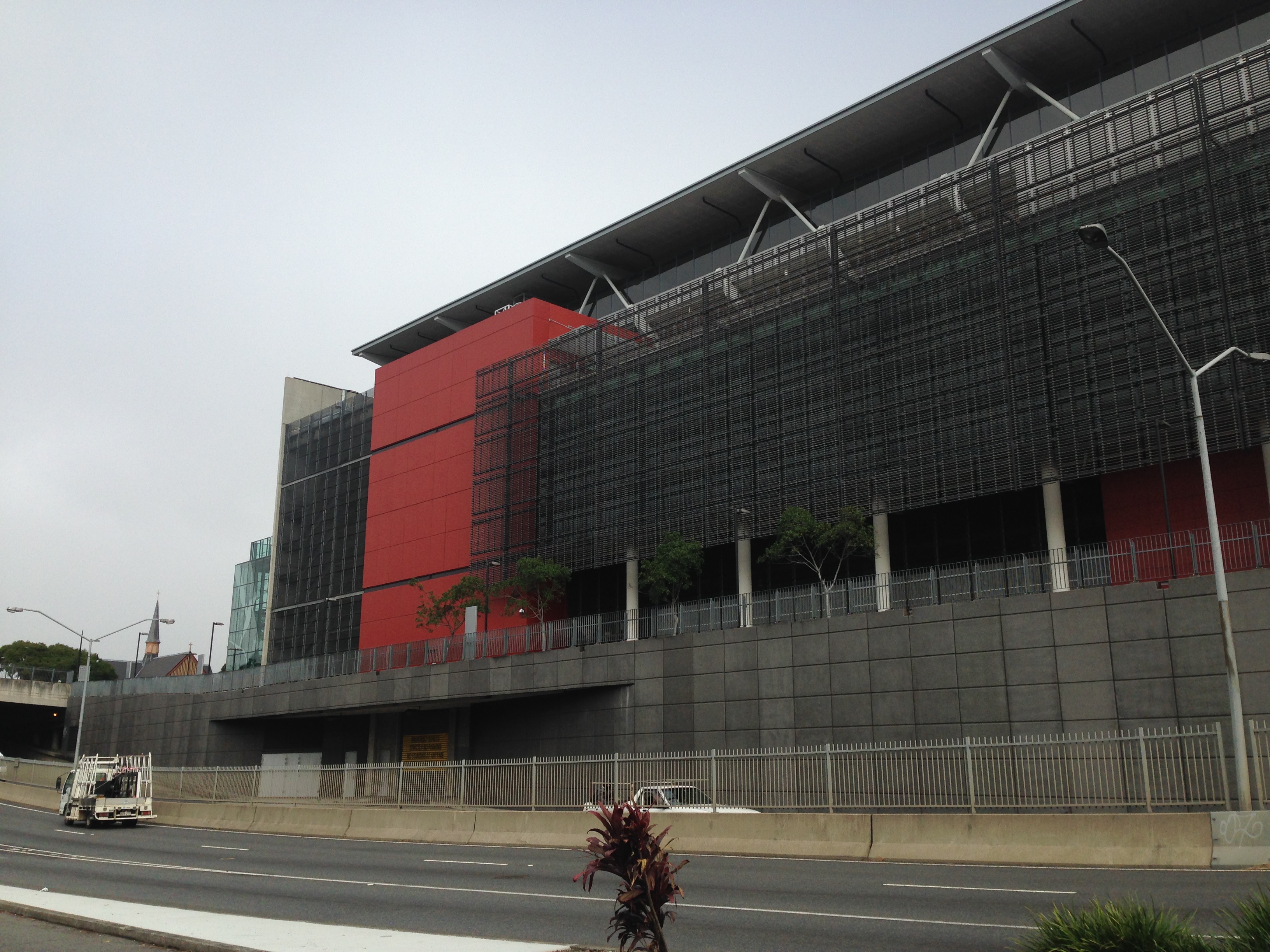


This is the Suncorp Stadium, so named because it holds a lot of football matches. Apparently, though, nobody here calls it that, instead preferring its original names like “Lang Park” or “Brisbane Stadium”. (Still better than naming your stadium after a cinematic universe — got that, Melbs?) Later in the day it will perhaps play host to a bunch of rowdy fans, all gathered here to shout and scream as their favourite teams wrestle and grapple with each other in that strangest of games called Australian football: for now, the only visible human is sitting at a gate underneath a side entrance. He rocks back and forth, as if breathing a prayer to the gods of sport for success. But the rest of the place is silent and desolate, and it’s hard to imagine the roar of the crowd that fills the stadium when the sun goes down. Not for the first time, the sheer brutality of size overwhelms.
Wandering out from under the shadow of the stadium, I take a better look at Milton itself. Although the CBD is just an escalator ride away, it already feels like I’m in a different place entirely. A street leading away from me bends up sharply, almost supernaturally, a freak of nature. San Francisco would look at this street and weep — and yet nobody seems to be batting an eyelid. Brisbane is pretty hilly by nature, and the streets are just this steep. It’s quite the shock for someone who’s spent four whole months in the flat plains of Melbourne: you never had to huff and puff just walking down the street. (For that matter, you never had to walk down a full street.) But perhaps I compare everything with Melbourne too much — this is another state, another capital, and using an already biased tape measure against everything makes me unable to appreciate this place on its own merits. I tell myself to calm down, keep an open mind as the bus arrives, and I hop on hesitantly.


The bus twists and turns as it winds its way through the suburbs, and begins to climb uphill. As we get further and further out of Brisbane Centre, the streets start getting insanely narrow — there’s barely enough room for a small sedan coming the other way, and I can almost see through the front windows of houses. I begin to worry that the driver has lost his way and that we’re just running through random narrow streets in a desperate attempt to find a path to the top, but apparently he does know where it’s going because we soon find ourselves at the Brisbane Planetarium, halfway up the hill — some of the people get off, but most people (like me) stay on the bus, waiting to get to the very top. We continue to wind, the trees getting thinner and thinner as we ascend to new heights of the seemingly unending mountain. The higher we go, the more evidence there is of sightseers: cars parked on the sides of the road, a café or two scattered across the road ahead. Then with a flourish the trees vanish, we make a left turn, and then suddenly we’re on top of the world.
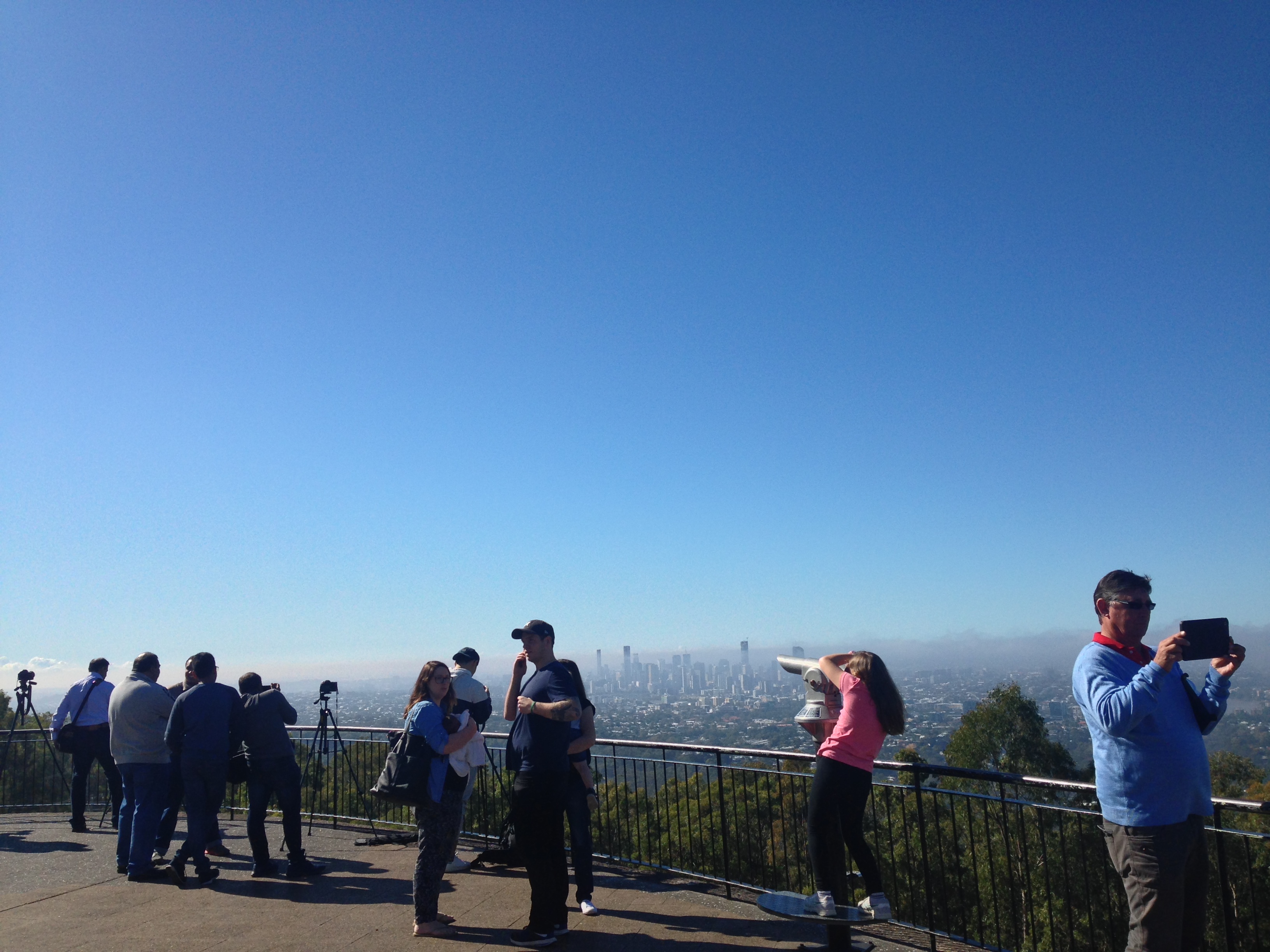


This is the summit lookout of the gloriously-named Mount Coot-tha, which takes its moniker from the Indigenous word for “honey”. There’s no sight of a hive anywhere, but there is a sweet, sweet view from the lookout. We’re a few miles and a couple of hundred metres up from the city centre, and from the top of the mountain, on a bright and sunny day, it looks like the most life-like painting I’ve ever seen. It’s so unreal — miles of blue up above, a few wispy bits of haze blanketing the tops of the skyscrapers, and yet I have never been more convinced that it is about to jump off the canvas, startle us all with the life within itself. Gertrude Stein once complained about a place because there was no there there: Brisbane proves itself worthy of that heavy word. My first impressions of the city, so dreary and dry, have been completely shattered, and such is the magnitude of my joy in discovery that for a teensy, tiny moment, I genuinely feel like shouting into the heavens. Instead, I take a plethora of pictures — to the point where my phone threatens to run out of memory.
There are crowds of people here, all enjoying the view and the Sun, so it’s a while before I notice a plaque nailed down to a tree stump sitting all on its own. Once I’ve gotten used to the blinding glare that comes from the metal plate, I realize that it’s an abstraction of the City of Brisbane, with its namesake river cutting through the middle of the circle haphazardly. Abstract to the point of absurdity, it still gives me a brainwave — all this time, I’ve been overthinking Brisbane, trying to judge which bits of it are good and which are bad. But Brisbane’s just a canvas, really, a cityscape on which you project yourself. What you see in it reflects what you’re feeling in it right then. Just sit down and enjoy whatever it offers your way.


Leaving the crowds and the Cantonese-speaking tourists behind, I begin walking down the hill. There’s a bus that takes me back down to the Planetarium, but it’s not for another 35 minutes and my addiction to walking/torturing my leg muscles is acting up again, so I decide to take an impromptu hike into the bush. I only have a vague idea of where I’m going, and here the bushscene is almost identical everywhere I turn — the Sun shining through a parched landscape of skeletal trees, fine dust creating a choking mist everywhere — but eventually I stumble past the charmingly-named Slaughter Falls and find myself, quite by chance, being vomited by the forest out onto the front lawn of the Brisbane Planetarium.

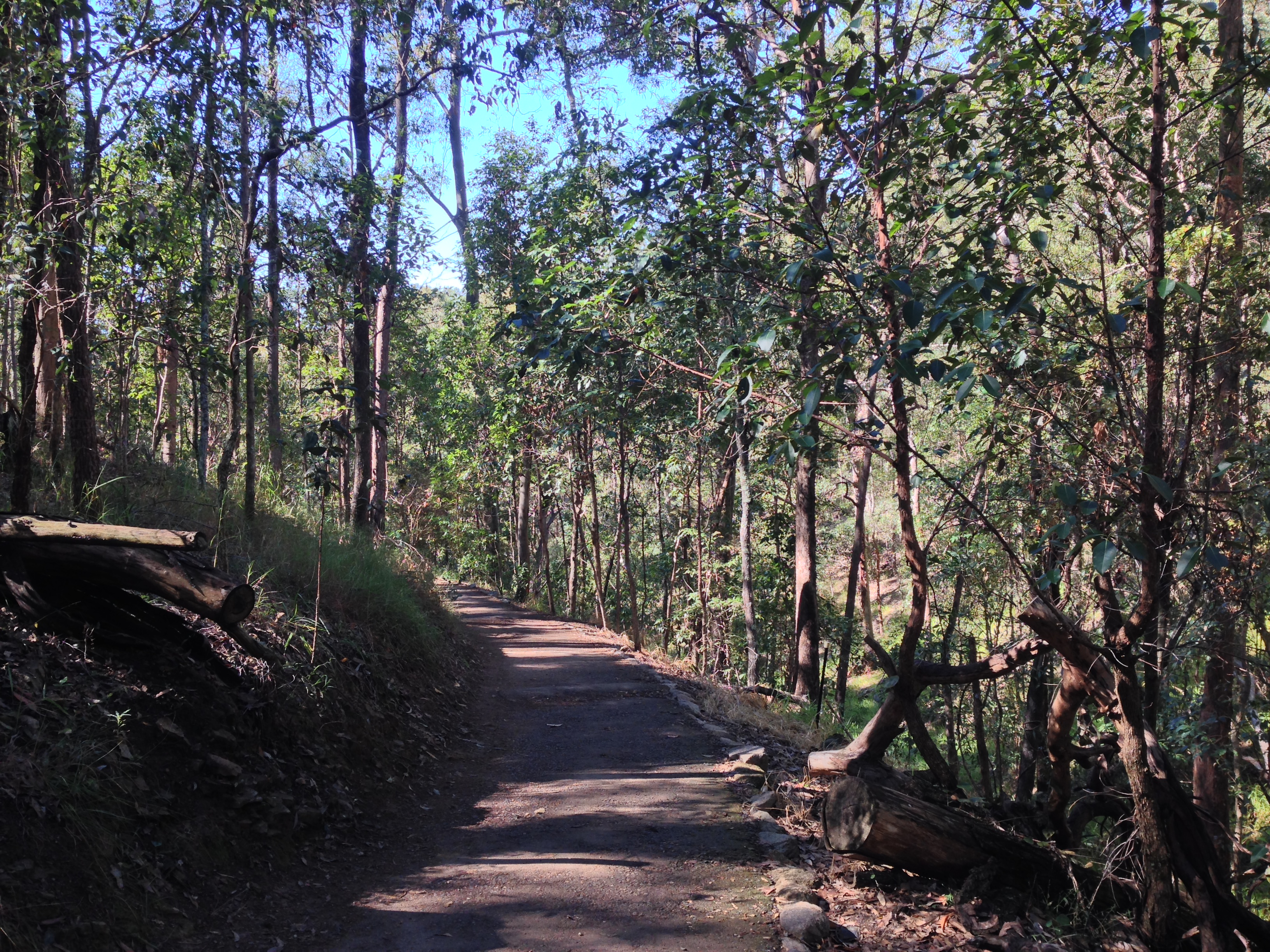

A small, squat, grey building, the Sir Thomas Brisbane Planetarium does not seem to hold many wonders. (Apparently it’s named after the namesake of the Brisbane River because he’d been an astronomer before he became governor of New South Wales. Just how rigorously did they vet these civil servants?) The dome, that must-have accessory for every self-respecting planetarium, is miniscule and seems to be hiding itself behind the cylindrical base of the building, and there is absolutely nobody here at the Planetarium even as tourists stream into the Gardens next door.
And maybe it’s just cause I’m used to planetariums looking like the most spectacular place on Earth — I’ve seen “La La Land” far too many times — but after walking about it for a bit of time, well it just doesn’t work. Given how deserted the place is, my first impulse to read this place as an underappreciated gem tempts, but does not bear fruit given how little fun this place has. There are a couple of interesting boards on Aboriginal interpretations of the skies, and the dome seems to have some pretty interesting show going on — though given how only sound is coming out of the doorway, and its intermittent interruption by construction noises next door, I’m not really sure — but besides that, nothing. Sigh and flip open my laptop — yup, I brought a laptop on a goddamn hike — to check my results for the term. They are the worst I’ve ever gotten since secondary school.


On my way out, I catch a glimpse of an armillary sphere, the sort which you might see in the Game of Thrones titles, and the one you see upstairs. Instead of deer and wolves fighting and stabbing each other, however, this one simply has the constellations drawn on its leather surfaces. I’ve always found mediaeval conceptions of the sky to be somewhat romantic, and although this one can’t possibly be more than a couple of hundred years old, it’s convincing enough that you can imagine it to be the real thinge. This might not be a satisfactory planetarium — there isn’t even a painted ceiling — but the astrolabe adds a splash of colour to what is otherwise a pretty dull place, and honestly, that’s the best you can hope for these days.
Lunch at the nearby café, where a sandwich and hot chocolate are dispatched without incident. The clock tells me I have a couple more hours to spend in Brisbane before I have to leave for the Airport. Happily, the perfect entertainment sits next door, and I’m shown the way in by statues of stuffy old men with hats and some outrageous nets.



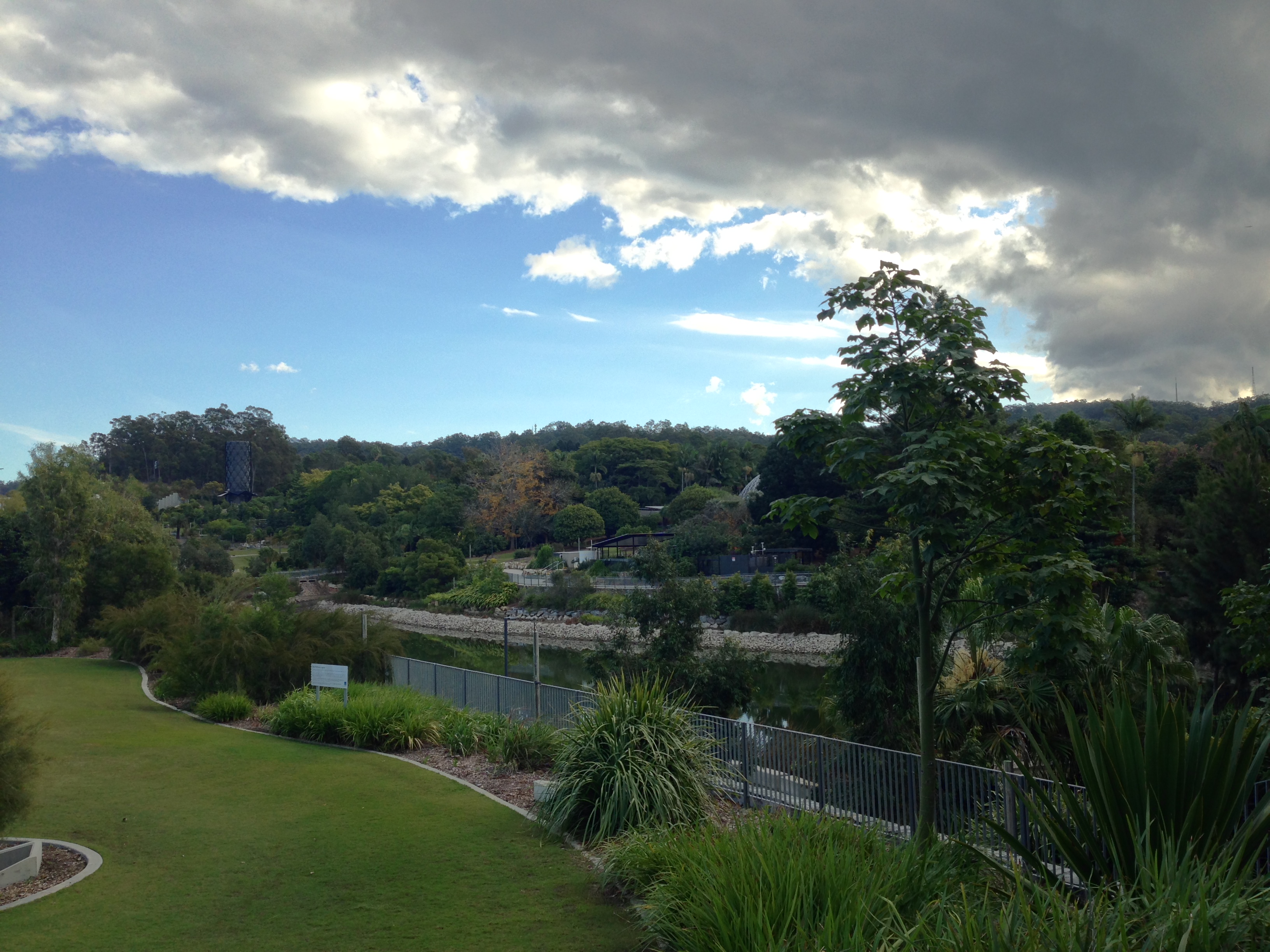

These are the Brisbane Botanic Gardens, a vast park sitting on the slopes of Mount Coot-tha (that name never ceases to be funny, you know?). Eagle-eyed readers may have noticed that this is not the first time I’ve mentioned a Brisbane Botanic Garden, and yes: this is a descendant of the one down by the river in the CBD. Most of the plants there were moved here in the 70s after they discovered that the river flooded far too often: no sooner had they found a new species of plant than it would be washed away. This being a rather undeveloped spot, they also went wild with the landscaping, and today the whole thing spans 130 acres (Winnie the Pooh would love this place) and more than 30 distinct zones. In other words, I have no chance of seeing everything before I leave for the city in a couple of hours.
Well then, challenge accepted. I set off towards what is evocatively marked the “lagoon” on my tourist’s map, but soon the Gardens throw their first obstacle at me. A network of criss-crossing paths that double back and leap on one another are not only literally in front of me — they are also marked, in vivid detail, on the map that I am holding in front of me. Adding to my navigational confusion is the fact that the scale of this map seems to be woefully off: within thirty seconds I have found my way past all of the intersecting paths without quite knowing how I’ve done it. Soon I pass a quiet pool of water that has yet another over-white statue sticking out of it. After craning my head a bit to see where the lagoon lies beyond it, it dawns on me that this IS the lagoon. It’s so incongruous amongst the lilypads and the tadpoles, I catch myself chuckling as I turn away from it and head for my next item.
I’ll be honest, even with all the confusing directions, I still managed to tick off a LOT of those items on the map, but you’re not here to hear me rattle off an inventory list of “10 Places You Must Visit in Brisbane’s Amazing Botanic Gardens”, so I’ll just try to describe them in general strokes. After stumbling around so many zones that had some sort of vegetation in them, you kind of lose track of where you’ve been. No, seriously: this place disorients you like no other place does. I recall walking into a space that was built like a river landing, and it was so quiet and cool, the foliage so dense, that I genuinely thought for a moment that I’d somehow walked into a greenhouse with an artificial stream running through it.

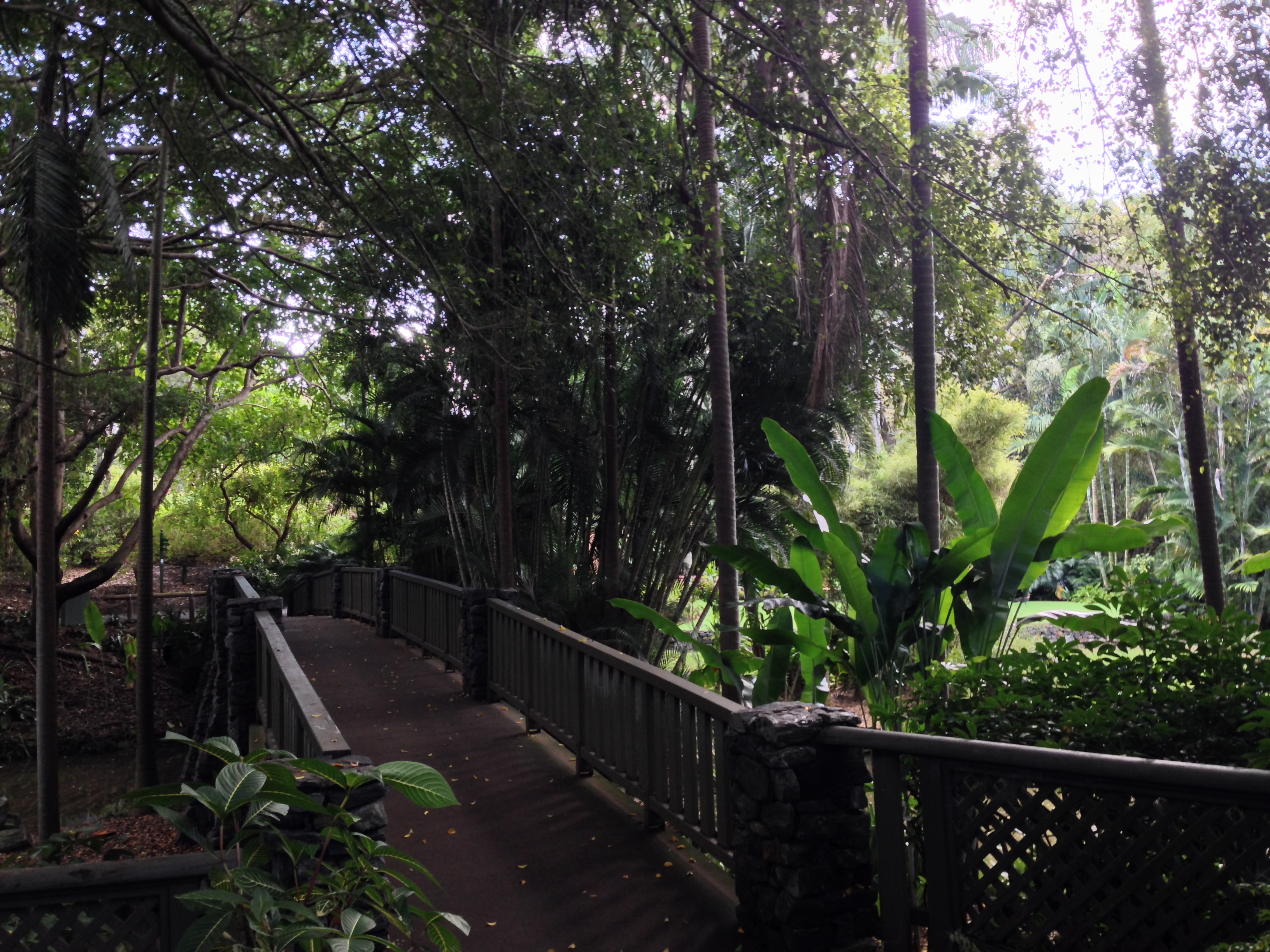


Coming out of the arbour, I turn the corner into an Asian-style garden with round doorways and even a bit of moody meditative music to boot. The sunlight streaming in from the open roof falls on an arrangement of potted plants, just sitting there like you might put them at home. To get from Amazon forest to Japanese garden in a few steps is mind-blowing, to say the least. (It was where I first learnt what “bonsai” meant — I thought it was a type of artillery before I walked in, and was very curious to see how they’d managed to fit Japanese bombs into the landscape.)
As always, though, it’s unconventional architecture that provides the clincher. In the middle of the Botanic Gardens is the Tropical Display Dome, a humongous greenhouse encased by triangle upon triangle of glass. It’s been very quiet the whole despite the tourists, but this place is especially so: nothing but the sound of gently trickling water and a few simulated birdcalls in here. The entrances are well-hidden from the inside, and your only glimpses of the outside world are tinted yellow, as if 19th-century movies are being played on every glassy pane. This time it really is like travelling into another world: one that’s proudly isolated from the outside, one where nature and artifice entwine to create a universe of its own. Plus, it’s the middle of winter, and any warmth, however unexpected, is nice.

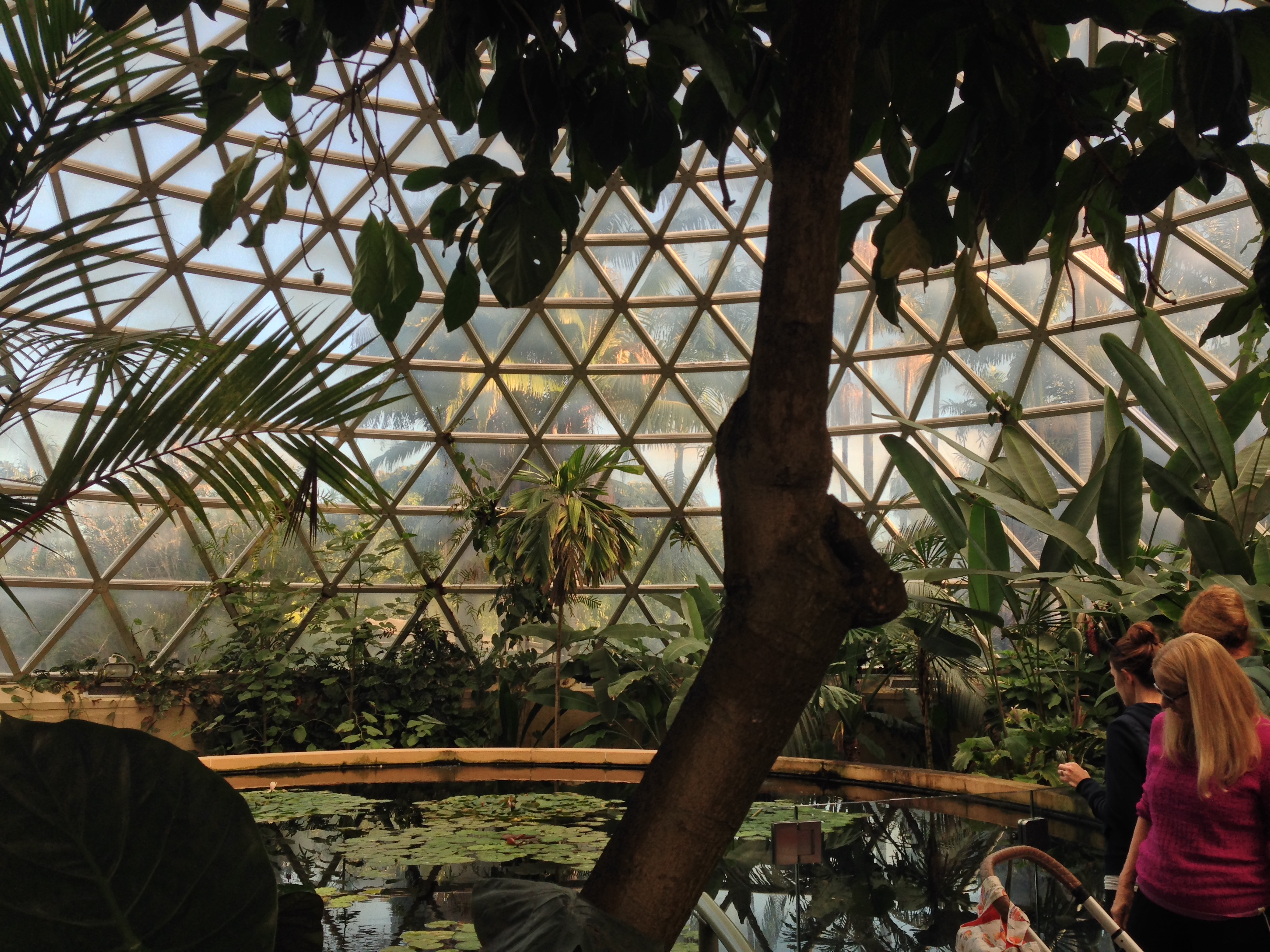
Quarter to five. Time to go — my flight leaves in three hours. As the Gardens sound the announcement for closing time, I slip out of the doors and head towards the bus station, in yet another side street shrouded with shadows. The roads tilt alarmingly, as if trying to hasten my descent back towards the heart of Brisbane. Yet I find my feet heavy, weighed down by a force that seems to drag me back. Perhaps I really do like Mount Coot-tha a lot, more than I care to admit, or perhaps it’s just general ennui at having to leave this place. In a few hours I’ll be on the final leg of my Australian journey; within a week I’ll be back in Hong Kong, a sweaty and stressful city where you never do get a chance to sit back and enjoy life.
“Do I want to go back to all of that?” is a question I’ve been asking myself ever since I passed the halfway point of my stay: despite all the unhappy events, all the losses in self-confidence I’ve had since the first flush of the relationship evaporated, I find myself still in love with Australia. Catching the bus that appears in front of me doesn’t feel like the capper to a lovely five months here — it feels more like a prelude to a figurative downward slope, the opening act of a comedown/depressive journey that means I’ll only feel more and more shit for the rest of 2018. I don’t want to take that bus. I don’t want to go.
Back at Roma Street, grabbing my bags, I discover that I’ve already missed the next Airport-bound train, and the one after that doesn’t leave Roma Street for another twenty minutes or so. If I walk across the river, though, one stop up the line, I can catch that later train while seeing Brisbane one last time: and so I walk down the street and onto the William Jolly Bridge one last time. It’s just after half past five, and the Sun is just about to make its final bow before turning in for night — and as I cross the Brisbane River, everything around me, the concrete, the cars, the water, everything is painted gold. Not the weak kind that dulls everything around it either: this is the kind that dazzles, bounces off everything around it, a liquid entity that flows and explodes past everything it touches. It’s one of the most beautiful things I’ve seen in all my travels, and it’s when I find myself waving goodbye to a landscape that I’ve come to know and love that I realize what it means to love a place. You develop feelings for it, you feel that you haven’t discovered enough. You feel that even its crummy bits — and I’ve seen so many in and across Australia — have a certain charm to them. And perhaps, I think as I walk up to what is cutely marked “Melbourne Street” just in front of South Brisbane station, I might even come back one day, this time to stay. There’s so much I want to see in this country, so much that I feel that I haven’t done — in Melbourne, in Sydney, in Perth and Darwin and all those places I haven’t been to. As the train glides through the city centre and into the suburbs, I find myself missing Australia. Even though I haven’t left it yet.
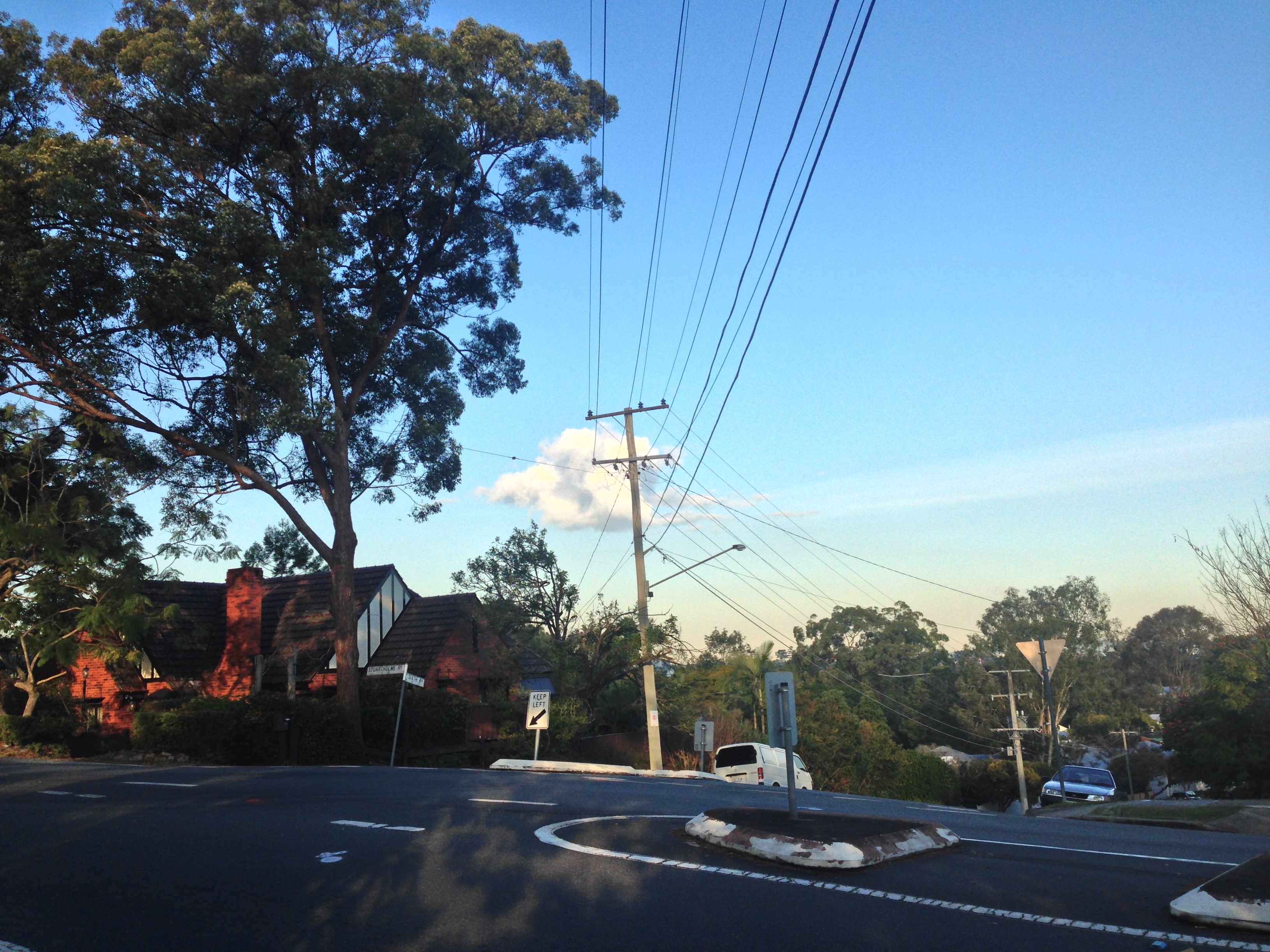




After the aptly named Eagle Junction, Brisbane fades away into the darkness as we ride on an elevated railway all the way into Brisbane Airport. But then, what do I make of Queensland itself? I’ve certainly loathed the place (Gold Coast is a stain on my memories that can never fully be erased) and loved it too (the Botanic Gardens, paradise on Earth). It has made me miss home — that is, Melbourne — more than any other place in Australia, and yet I’ve just experienced a dragging of the feet, a reluctance to speed home. It’s a strange place that makes you want to leave and stay at the same time, almost schizophrenic in its push and pull.
Off at the terminal, the end of the line. Domestic station is a wonderful structure, a concrete glow-worm in the dark, beautifully and softly lit. Plenty of time to think, since my flight — and all others of the airline — have for some reason been delayed for an hour and a half. Maybe have dinner, make the best of things. Then again, that’s the thing about travel itself, isn’t it? No place can be truly perfect, even though we like to paint places as one or the other. We look for heaven and hell in places where there is just a there, and we think too much about whether a place suits our vision at that moment in time. Maybe I’ve been overthinking this, both for Australia and for the European one I wrote before. Maybe travel writing just stems out of a desire of mine to find out, more clearly, what my loves and hates are. I don’t know, really.



And so as the night plane to Melbourne takes off into the night and I say goodbye to both Queensland and this travel narrative, I find myself without an adequate ending, not even an idea of what to think about all I’ve seen. Perhaps it’s for the best. Perhaps representing life and travel like this — as a confusing collage of images that assemble in your mind to form experience, like dreams often do — is the best way to leave it. That’s all I can say.